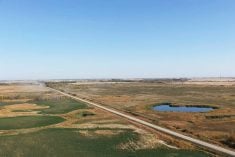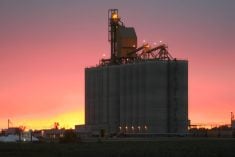The incidence of sclerotinia stem rot in Saskatchewan oilseed crops was up in 2016, said Matthew Bernard, Saskatchewan provincial oilseed crops specialist. Bernard presented the results of the Saskatchewan Ministry of Agriculture’s 2016 canola disease survey at Oilseed Producer Meetings around the province in mid-November.
In Weyburn, Bernard told oilseed growers, “there were 224 canola crops surveyed.” These 224 fields were spread across the province. Surveyors approached every canola field the same way: they stopped at five points in a “W” pattern throughout the field. At each of these five points they selected 20 plants for testing. This made a total of 100 plants per field, or a total of 22,400 canola plants tested altogether.
This annual survey documents the prevalence, incidence and severity of each disease. Prevalence, Bernard explained, is “how many of those fields surveyed had the disease.” Incidence measures “how many of the individual plants, of those surveyed, were infected.” The severity rating measures “the extent of potential yield loss in the plant.” So, a disease may be “prevalent” in a field, but with a low “incidence,” meaning that only a few of the 100 plants surveyed in the field were infected with the disease.

Sclerotinia survey
In 2016, 92 per cent of the 224 crops surveyed in Saskatchewan had at least trace levels of sclerotinia stem rot. This is higher than last year (66 per cent) and the year before (17 per cent in 2014).
The incidence was also higher — an average of 26 per cent of plants in infected fields were infected with sclerotinia stem rot. Last year, surveyors found only 11 per cent infected; 18 per cent were infected in 2014. “Incidence is very dependent on the environment,” Bernard says. Wetter conditions in 2016 are evident in these results.
Surveyors rated sclerotinia damage using the standard scale of one to five, with a five rating being the most seriously infected. A one rating indicates minimal potential for yield loss; a three rating signals a 50 per cent yield loss.
In 2016, sclerotinia was most prevalent in west central Saskatchewan, where it was found in all surveyed fields, “but it was most severe in east central. You see the higher severity rating there,” Bernard said.
Blackleg survey
Including fields where there were no infected plants, the province-wide average incidence of sclerotinia was estimated at 24 per cent for 2016. Based on this estimate, Saskatchewan’s Ministry of Agriculture estimates Saskatchewan’s yield loss to sclerotinia at roughly 12 per cent. “With sclerotinia, as a general rule of thumb, to predict potential yield loss, for every one per cent of incidence, you can predict a 0.5 per cent yield loss,” Bernard said.
“Blackleg was prevalent in 61 per cent of the crops surveyed,” Bernard told participants at the Weyburn meeting. That compares to 59 per cent in 2015 and 55 per cent in 2014.
While the disease was prevalent in more than half of surveyed fields, the average incidence of disease was only 12 per cent, meaning that, on average, where blackleg was found in the a field, only 12 of the 100 tested plants were infected. This is slightly lower than the last two years when the incidence of blackleg has been 15 per cent.
“Blackleg was most prevalent in the northwest, whereas it was most severe in east central.”
Blackleg severity is rated on a scale of zero to five. “Right before swathing, the plant will be clipped off just above the soil,” Bernard said. The clipped stems are inspected for apparent diseased tissue and rated “based on the relative amount of infected tissue in that cross section.”

Clubroot survey
Surveyors took soil samples at the entrance of each of the 224 fields, the area where soil is most likely to be contaminated. Those samples are being tested for clubroot DNA. Results are not back yet. No clubroot was found through this survey in Saskatchewan in 2015 or 2014.
















